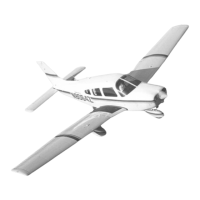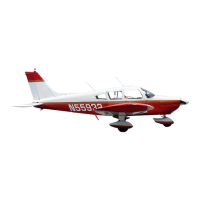PIPER AIRCRAFT, INC.
PA-28-161, WARRIOR III
MAINTENANCE MANUAL
PAGE 1
Nov 30/06
3J7
37-20-00
INDICATING
The following information is intended to aid in diagnosing vacuum system service symptoms on those
components which are serviced by removal and replacement (i.e. - vacuum gauges and switches).
1. Vacuum (Suction) Gauge
The suction gauge is mounted on the left side of instrument panel. This gauge is calibrated in inches of
mercury and indicates amount of vacuum created by the engine-driven vacuum pump. The suction
gauge has a direct pressure line and a vent line. Therefore, the gauge indicates differential pressure or
actual pressure being applied to gyro instruments. As the system filter becomes clogged or lines become
obstructed, the gauge will show a decrease in pressure. Do not reset/readjust the vacuum regulator until
the filter and lines have been checked.
A. Service Tips
(1) Vacuum gauges seldom require service and usually are replaced when malfunctions occur.
NOTE: Vacuum gauge failure in a properly operating vacuum system does not impair
safety of flight.
(2) If the vacuum gauge malfunctions in a manner to cause an incorrect reading in normal cruise
conditions, the gauge must be checked by comparing its reading with a gauge of known
accuracy. If the gauge is confirmed to be indicating correct values and system vacuum level is
not in accordance with specified vacuum, then and only then should the vacuum regulators be
reset/readjusted.
(3) Visual examination of gauge performance should cover the following steps:
(a) With engine stopped and no vacuum supplied to gauge, its pointer should rest against the
the internal stop in the 9 o’clock position. Any other displacement from this position
suggests need for replacement.
(b) A slight overshoot during engine startup, not to exceed half an inch of mercury, is normal
and is not cause to replace gauge.
(4) With engine operating at normal cruise RPM, gauge should read within the normal operating
range as marked on the gauge.
NO
TE: The normal operating range is 4.8 to 5.2 IN. HG.
(5) At 1200 rpm, vacuum gauge reading should be more than four inches of mercury.
(6) Airplanes equipped with the optional auxiliary vacuum pump installation can check the gauge
by turning ON the BATT MSTR and VAC OFF - AUX ON switches.
B. Removal and Installation
The vacuum gauge is a face-mounted instrument. See 39-10-00.

